Richard Webb, former managing director of Trinity Mirror’s UK nationals division, writes at The Guardian about newspapers in the UK in the face of another decline in newspaper circulation:
It is said that that cockroaches can survive a nuclear holocaust. While newspapers are facing the worst financial crisis in living memory, they too, are survivors and I wouldn’t be surprised if many find ways to survive this trial.
Yes, their circulation revenues are under the cosh from declining sales and now advertising is suffering too. As profits plummet, the outlook is not good. Logic suggests we will soon be seeing multiple closures.
Wirting at Fox News, Dan Gainor, Vice President Business & Media Institute weighs in on the future of newspapers:
Once newspapers were the answer to the riddle: “What is black and white and read all over?” They’re no longer just black and white, but they are red all over. Red ink spills off nearly every page onto balance sheets across America.
The newspaper business is bleeding to death.
For another perspective, read what Walter Isaacson, former managing editor of TIME and president and CEO of the Aspen Institute, has to say in the current issue of TIME under the headline of How to save your newspaper.
Newspapers are in trouble around the world, as further evidenced yesterday with the latest earnings results from News Corporation. No amount of effort from newsagents can address the national or global trend. What we can an must do is manage our financial, real-estate and labour investment appropriately in the loght of these challenges. While we risk speeding to an outcome, it is time newsagents put their businesees first in the face of such a considerable and obvious shift in how people are accessing news and information.


